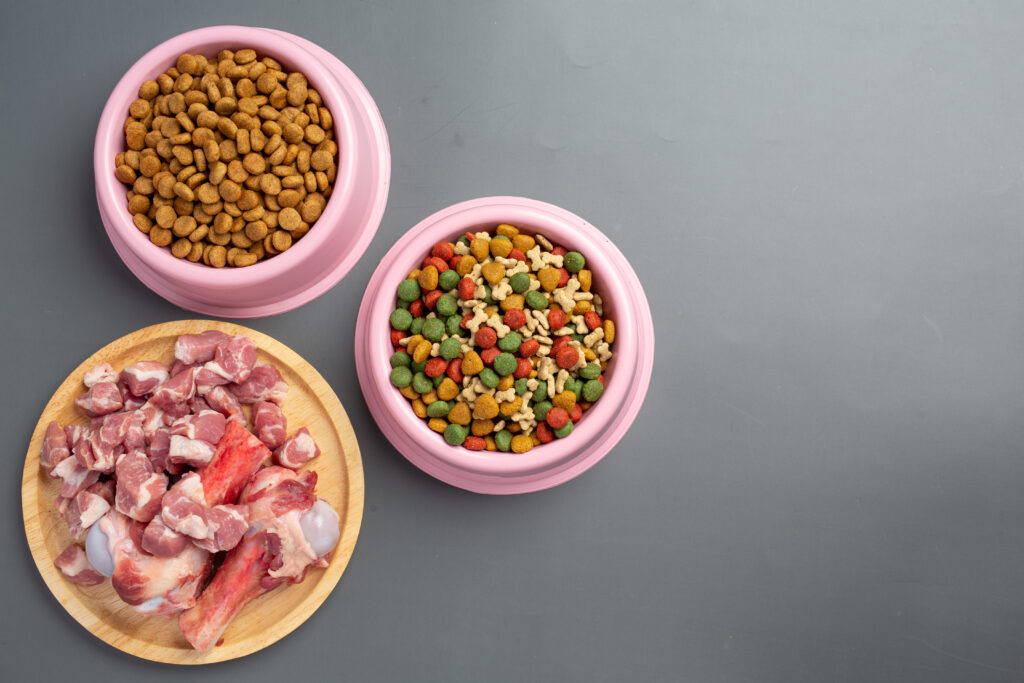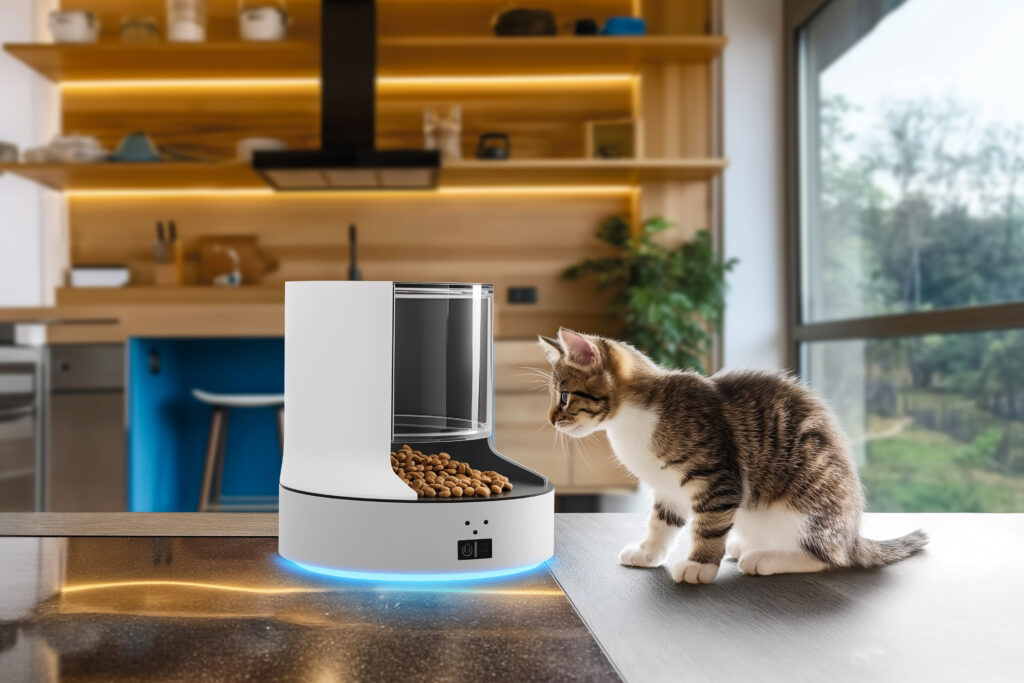
Welcome to our blog post on how to stop older cat from eating kitten food for pet owners. If you’re wondering how to prevent this common issue, you’re not alone. Many pet parents face this challenge, especially in multi-cat households. Older cats eating kitten food can lead to weight gain and nutritional imbalance.
In this detailed guide, you’ll discover vet-recommended tips like
- Consult your vet if the behavior persists
- Setting separate feeding zones
- Using microchip-activated feeders
- Engaging senior cats with puzzle feeders
- Monitoring eating habits
- Creating a structured feeding schedule
- Why Does My Older Cat Eat My Kitten's Food?
- The Importance of a Proper Feeding Schedule for Cats
- 7. Top 7 Tips to prevent your older cats from eating kitten food
- Table: 7 Tips to Stop Older Cats from Eating Kitten Food
- Separate Feeding Zones
- 2. Stick to a Feeding Schedule
- 3. Try Automatic Microchip Feeders
- Things to Know Before Buying a Bundle of PETLIBRO Upgraded RFID Automatic Cat Feeders
- 4. Engage Your Older Cat with Puzzle Feeders
- 5. Monitor and Adjust Feeding Habits
- 6. Adjust the Setup as Needed
- 7. Consult Your Vet
- Personal Experience
- Conclusion
Let’s dive into practical and effective solutions to ensure that each cat gets the right food based on their age and health conditions.
Why Does My Older Cat Eat My Kitten’s Food?
Feeding several cats at once may be difficult, especially when your elder cat begins choking on kitten food. Though it may look harmless, proper behavior correction must be done to cater to the basic needs of the older cat and the kitten.
Kitten food is designed to support rapid growth and high energy needs. Older cats don’t need that richness. Feeding the wrong type can lead to digestive issues and unwanted weight gain.
The Importance of a Proper Feeding Schedule for Cats
A structured feeding schedule is not just helpful—it’s crucial. It offers a simple way to:
- Control food portions
- Prevent grazing all day
- Monitor your cats’ appetite
By feeding at fixed times and picking up food afterwards, you reduce the chances of the older cat eating the kitten’s food during unsupervised hours.
7. Top 7 Tips to prevent your older cats from eating kitten food
Below are the 7 best methods for how to stop an older cat from eating kitten food
However, for proper feeding to be done, there should be a proper feeding schedule as well. Thus, a feeding schedule is likely to offer an easier method of regulating the number of rations offered to each cat and portions of the food. Its use is to prevent the older cat from eating the food given around for the kitten until they are scooped in the morning.
Table: 7 Tips to Stop Older Cats from Eating Kitten Food
| Tip | Description | Why It Works |
|---|---|---|
| 1. Separate Feeding Areas | Feed cats in different rooms or corners. | Prevents direct access and food competition. |
| 2. Use a Feeding Schedule | Feed at fixed times and remove food after. | Controls access and prevents free grazing. |
| 3. Microchip Feeders | Feeders that open only for the assigned cat. | Ensures only the kitten eats kitten food. |
| 4. Puzzle Feeders | Engages older cats in play to get food. | Keeps them occupied and slows down eating. |
| 5. Monitor Eating Habits | Watch for unusual food-stealing or behavior. | Helps you catch problems early. |
| 6. Adjust Based on Observation | Modify the setup based on what you see. | Tailored solutions for your specific needs. |
| 7. Talk to a Vet | Get personalized health and diet advice. | Ensures both cats are healthy and well-fed. |
Separate Feeding Zones
One of the easiest fixes is to simply feed the cats in different areas. If possible, put the kitten’s bowl in a room with a door and keep the older cat’s food elsewhere. If separate rooms aren’t available, use corners and visual barriers.
This not only reduces food competition but also helps you create specific feeding spots each cat recognizes as their own.
2. Stick to a Feeding Schedule
A feeding schedule creates structure. By offering meals at the same time each day—and removing leftovers—you eliminate opportunities for the older cat to sneak in and eat the kitten’s food later.
It’s a simple yet effective technique to manage feeding routines.
3. Try Automatic Microchip Feeders
Bundle of PETLIBRO Upgraded RFID Automatic Cat Feeder, 2 Packs 5G Wi-Fi Automatic Pet Feeder,
As a cat parent in a multi-cat household, I can’t recommend the PETLIBRO RFID Automatic Cat Feeder enough. I use it every day, and it has completely changed the way my cats eat. Before this, I was constantly stressed about food stealing and different diet needs, but now each cat has their own feeder and their own collar tag, so there’s no more confusion or conflict during mealtimes.
The smart collar tag is a game-changer. It only opens when the right cat approaches, which keeps feeding exclusive and stress-free. I especially love the real-time eating data on the PETLIBRO app—now I know exactly when and how often each of my cats eats. It gives me peace of mind, especially when I’m not home.
Scheduling feeds through the app is super easy, and I’ve even used the manual feed option to give a quick treat. The 3L capacity lasts about two weeks for one of my cats, so I don’t have to refill constantly. Plus, the adjustable lid speed helped my shy cat get used to it faster.
What impresses me is how fresh the food stays. With its five-layer sealing system and desiccant, kibble never goes stale.
If you’re dealing with food aggression, different diets, or just want smarter feeding, this feeder is worth every penny.
Things to Know Before Buying a Bundle of PETLIBRO Upgraded RFID Automatic Cat Feeders
Before buying the PETLIBRO RFID Automatic Cat Feeder bundle, make sure it fits your household’s specific needs, especially if you have multiple cats with different diets or food behaviors. It’s a smart, reliable choice—but it works best when used correctly.
Key Points to Know:
- 🔐 Only works with included RFID collar tags — Not compatible with microchips or third-party tags.
- 🐾 Ideal for multi-cat homes — Helps prevent food stealing and supports unique feeding schedules.
- 📱 App control required — You’ll need the PETLIBRO app for real-time monitoring and setting meal times.
- ⚙️ Adjustable lid speed — Helps pets adapt easily; choose from 3 lid speeds.
- 💧 Don’t wash the base or RFID sensor — Keep it dry to avoid damage; follow care instructions.
- 🍽️ 3L capacity per feeder — Holds about two weeks of food for one cat.
- 🔋 Use original charger only — For safe and stable performance.
- 🌬️ Sealed for freshness — Built-in silicone seals and desiccant bag keep kibble fresh and crisp.

Microchip-activated feeders are high-tech gadgets that open only for a specific cat. These feeders recognize your cat through a built-in chip or RFID tag and allow only the designated pet to access the food.
It’s a reliable solution to stop food stealing, especially if your older cat is persistent.
4. Engage Your Older Cat with Puzzle Feeders
Puzzle feeders are both mentally stimulating and useful for controlling how quickly your older cat eats. These devices make cats work for their food by solving small challenges.
Not only do they slow down eating, but they also distract your senior cat from the kitten’s food.
5. Monitor and Adjust Feeding Habits
Keep a close eye on your cats during mealtime. Observe patterns—is your older cat sneaking around during kitten feeding? Is it eating too fast?
Depending on what you notice, you might need to:
- Move feeding stations
- Change feeding times
- Use puzzle toys or barriers
It’s all about testing and tweaking what works best for your cats.
6. Adjust the Setup as Needed
No two cats are the same. You may need to experiment a bit. Try various combinations—some households thrive with timed feeding, while others do better with feeding stations in different rooms.
Be flexible and responsive based on what works.
7. Consult Your Vet
Finally, if nothing seems to work or if your cat’s behavior is unusual, speak with your vet. They’ll help determine whether the problem is behavioral, medical, or dietary.
Sometimes, food stealing could be a sign of hunger, health issues, or stress. Your vet will guide you to meet both cats’ nutritional and wellness needs.
The automatic microchip feeders seem like a modern way to ensure your older cat is not feeding on kitten food. These feeders come with sensors that identify your cat through his microchip or an RFID collar tag.
The feeder is connected with the movement detector; when the feeder recognizes your cat, it opens to provide access to the food. This will help to guarantee that the feeder is only for the registered cat. The ones with an automatic microchip feeder allow you to manage portions while denying your older feline the opportunity to take the kitten’s food.
Personal Experience
When I first brought a tiny, playful kitten into our home, I had no idea my older cat would start sneaking into her food bowl! It seemed harmless at first — just a few bites here and there. But I started noticing changes in my senior cat’s behavior and weight. Kitten food is richer and meant for fast growth, which my older cat didn’t need.
I tried shooing him away during feeding time, but it didn’t work. What finally helped was a microchip feeder that only opened for the kitten, and I added puzzle feeders for my older cat to keep him busy. Slowly, the habit broke.
It took patience and consistency, but now both my cats eat happily in their own spaces, and I feel much more confident that their nutritional needs are being met. Every cat is different, but with small adjustments, you’ll see results too.
Conclusion
There’s no need to panic if your older cat sneaks a few bites of kitten food, but over time, this habit can lead to nutritional imbalance and health risks. Luckily, with a multi-step plan and some vet guidance, you can manage it effectively.
If you’re wondering how to stop an older cat from eating kitten food, the key lies in being consistent with separate feeding zones, scheduled meals, or using high-tech feeders. Pay attention to your cats’ needs and behavior, and with time, your home will become a place of happy, healthy eating for all your furry friends.
